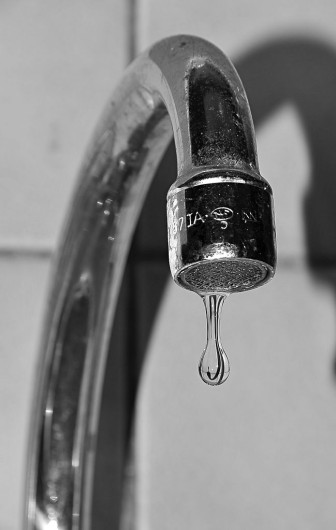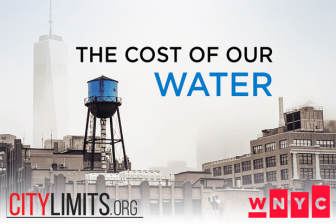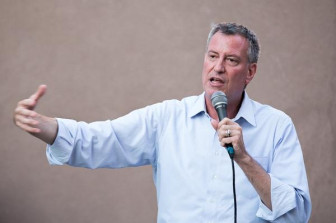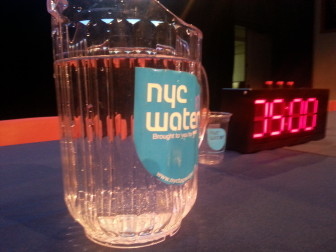
Nicole-Koehler
New Yorkers are using less water than they did two or three decades ago, but paying more because of the rising fixed costs of running the system,
Throw a dart at a world map and you’ll hit water woes. California’s governor this Spring announced water restrictions to deal with worsening shortages. Ireland saw protests last fall over plans to for a new, separate water tax there. A 2012 intelligence assessment found that “during the next 10 years, many countries important to the United States will experience water problems—shortages, poor water quality, or floods—that will risk instability and state failure” and predicted water trouble would create public health problems along Central Asia’s key Amu Darya river and food scarcity in the Brahmaputra basin running through Tibet, Bangladesh and India.
And then there’s the issue that was on display late in April in the function room of a church on Avenue D in East Flatbush, where City Councilman Jumaane Williams held an information session on tax liens.
Liens are claims against the property of an owner who’s behind on his payments to the city. The city sells those claims to private investors who try to collect. Typically, liens reflect unpaid property taxes and, sure enough, there were four representatives of the city’s Department of Finance on hand for Williams’ event.

All this week, a joint City Limits-WNYC reporting partnership will broadcast and publish stories about New York City's incredible water system and the challenges it faces.
But next to them were 11 staffers from the Department of Environmental Protection (DEP), which runs the city’s water system.
Alex Romao was there to meet one of them about the $7,400 he owed in back water charges. “They’re willing to help me out with an agreement. They’re very accommodating,” he said. “My mom left me the house. She died many years ago. So it accrued. This house wasn’t a priority. Now it is.”
Of the 15,000 liens slated for sale by the city in May, nearly half—48 percent—only involved water charges. New York City does not sell liens on single-family homes. But all property in New York has seen a dramatic rise in water rates. In the past 10 years, the base charge for water in New York City has soared 131 percent—well ahead of the 41 percent increase in the city’s median rent.
That’s despite the fact that New York City’s water consumption is 30 percent lower today than in 1990. Even adjusted for inflation, New Yorkers are paying more for water though they are using less, and it’s having an impact on affordability.
‘A huge hit’
When the University Neighborhood Housing Program, a Bronx nonprofit that assists and finances affordable housing, surveyed 34 buildings run by nonprofits, it found that water costs on average ate up 13 percent of expenses. “That’s a huge hit out of the operating budget,” says Jim Buckley, UNHP’s executive director.
Earlier this month the city’s water board passed a rate increase for fiscal year 2016, which begins July 1, of 2.97 percent—the smallest hike since 2001. DEP predicts that rate hikes over the next three years will be similarly modest. But the four consecutive years of two-digit rate increases during the Bloomberg administration mean that water rates have already reached a troubling level.
“Water is one of the largest expenses we have to operate a building,” says Mark Engel, a property manager who oversees 9,000 units in Washington Heights and the Bronx. “Right now, the cost of water is the same as heating a building. We pay as much for water as we do for oil.”
New York City water customers are billed both for the water they use and the sewage they generate. The city doesn’t measure your personal sewage output—it just layers a 159 percent wastewater charge on whatever you pay for water. Among the nation’s 30 largest cities, water charges in New York City are in the middle of the pack. New Yorkers on average pay far less than Seattle or San Francisco residents, and substantially more than people in Chicago or Miami. But New York is different from other cities, not just in size, but also in the high percentage of people who rent rather than own and the sheer number of people living in poverty.
Why some pay more
Renters are usually insulated from the cost of their water use. Landlords may be able to roll higher building-wide water costs into the rent hikes he imposes the following year, but a renter usually doesn’t have to foot—in fact, doesn’t even get to see—his water bill directly.
Low-income people, meanwhile, tend to use more water at home. Household sizes can be larger and while higher-income people do some of their flushing at the office or school, there is often someone at home during the day in low-income households. Plus, poor people can’t afford vacations, during which a traveller basically gets someone else to pay for his water.
Taken together, that can make for hefty water bills at low-income buildings, says Engel. “If we had to pay by use, we could never afford it.”
Thanks to a DEP program, Engel doesn’t have to pay a water bill based on what his tenants use. Instead, through a mechanism called the Multifamily Conservation Program, he pays a flat fee per unit. The charge this coming year will be $1,005, a shade less than DEP estimates the average household pays under the regular system.
DEP takes other steps to reduce the impact of water charges, like sending leak notifications when a customer’s usage spikes and allowing households to track their consumption in real time. But it also can shut water off to deadbeat customers, which Water Board documents indicted has been done to “a small number of single family residential properties.” DEP says it has sent several thousands accounts to its collection agency, which had nabbed $7.7 million through the end of last year.
That get-tough attitude is fairly new. In 2006, a New York Times investigation found that DEP had “failed to collect on millions of dollars in overdue water bills because its records are so riddled with factual errors and outdated information that pursuing deadbeats and delinquents has become virtually impossible.”
In fact, the city’s whole approach to water billing is fairly novel. Water used to be charged on a frontage basis, meaning customers paid according to the size of their buildings. In the early 1990s the changeover to metering began. It’s probably one reason why consumption has dropped. But it also has led to low-income households shouldering a large share of the burden of supporting the system. And, Buckley says, that was expected when the new system began. “People knew this was going to happen,” he says.
Mayor de Blasio’s recent OneNYC report concluded that water charges are “particularly hard to bear for low-income homeowners and providers of affordable housing.” Even with the Multifamily Conservation Program, many buildings still display sharp disparities in what they pay for water. A recent study by UNHP compared a Manhattan building, where the average rent is $2,772 a month, to a Bronx building whose tenants paid an average of $756. The Manhattan building spent $622 per apartment over a year for water, while the Bronx building forked over $975 per unit. As a share of rental costs, the Bronx building paid five times as much for its water.
Paying the ‘rent’
Advocates have been sounding the alarm about water rates for years, and their ire has traditionally focused on what’s known as the “rental payment.”
Prior to the mid-1980s, the city owned and ran the water system like it does the fire or police departments. Then the city split the water system off in an effort to lure bond investors. Since some of the old debt taken on to build the water infrastructure was still on the city’s books, it was arranged that the water system would pay a fee back to the city to cover the debt service on those old bonds. In a way, the water system was renting the pipes and plants from the city that paid to build them—hence, it’s called the rental payment.
Three decades later, that old debt has been whittled down, so the annual rental payment is largely a gift from the water system to the city—and a controversial one, since water fees can be regressive. The city has begun refunding part of the rental payment back to the water system at year’s end, and the de Blasio administration last month indicated it would move toward phasing out the rental payment.

Karla Ann Cote
Mayor de Blasio, seen here as a candidate in 2013, when he promised to address problems with the water rate. He recently committed the city to doing that.
“My view on the water rate is that it needs to be aligned to the actual cost of running the water system and all the relevant parts of running the water system,” the mayor said this week. “The fact is – there are some new and substantial costs related to the water system. But what we need to do is move away from the history where some of the water bill costs actually didn’t reflect the cost of water. So we’ve made additional steps in that direction.”
“It’s going to take us at least several more years to, once and for all, end that, but I think we’re moving in the right direction,” the mayor added.
This year, the amount of the rebate is significant—$244 million—but that only constitutes 6 percent of the DEP budget. That means changing the impact of water rates will involve more than the relatively easy step of shutting off the spigot to the city’s general fund. A number of people are now calling for a deeper rethink of how water charges are calculated.
A new way to pay?
To critics like Buckley, the problem with water fees is that most of the money they raise pays not for the day-to-day operation of the water system but for the cost of building water infrastructure. That’s why New York City water charges have risen every year even as water consumption has dropped: The amount of water we use doesn’t drive water costs nearly as much as the price of building water plants and pipes.
What’s more, that infrastructure is beneficial to customers regardless of whether they use it a lot or a little. The UV plant that protects us from Cryptosporidium and Giardia, for instance, is pretty much of equal value to a household of one as it is to a family of seven, even though that later shouldering much more of the cost. Similarly, the water main under your street is of vital importance chiefly to you and your neighbors, but someone three miles away who uses the water system more pays more to maintain it.
Plus, that infrastructure has to exist regardless of how much water the system uses: We could all agree to take but one shower this year (ok, who’s with me?) but that UV plant would still need to be paid off. Our bills would just rise to make the math work.
“No matter what measures we take to reduce the cost of water in our buildings, within a couple of years the city’s going to have to raise your rate anyway,” says John Reilly, the executive director of Fordham Bedford Housing Services in the Bronx, which manages affordable housing. “If we just didn’t use any water, the city would still have to send us a big bill because they have to pay for the pipe that’s there, for the filtration that’s there, for the sewer system that’s there—whether we’re using it or not.”
Even if the bills are growing more slowly these days, Councilman Williams the increases still have a real impact on constituents who are homeowners or small landlords. “People can’t even budget for it,” he says. “I can see how it’s not as big as a mortgage but it’s not insignificant. A few thousand dollars a year breaks down to a few hundred a month. And if you can’t pay that first one, then it snowballs.”
UNHP in April called for DEP to add a new “affordability cap” to the multifamily Conservation Program to protect buildings with low-income residents and modest rent rolls from higher fees. But that’s just “a first step in a larger strategy to develop a fair and equitable water and sewer rate setting formula for New York City,” their report said.
“We’re trying to find a fair balance between the issue of conservation and cost and trying to address the regressive nature that we feel that the current system has built into it,” Buckley says. “We would like to get the water rate formula revisited. It doesn’t account for what reality is today. To make the ratepayers pay for everything doesn’t continue to make sense. “
The next step for the city, some advocates say, could be “tiered rates.” With tiered rates, the rate a customer pays for every gallon increases if their use crosses a threshold: You might, for example, pay $5 a gallon for the first 500 gallons a month and $7.50 per gallon after that. It makes the customers who put serious strain on the infrastructure pay more for its upkeep and it could reduce the water-rate disparities among most households if they end up in the same tier.
The price of rain
Reformers also want DEP to take a closer look at water that no one uses: rain. DEP estimates about 10 percent of its costs come from handling stormwater that runs off the city’s impervious surfaces, often into the very expensive sewer system. Right now, those stormwater costs get lumped in with the other expenses passed on to ratepayers. But water rates don’t align with how much stormwater customers actually generate. Some parking lots, for instance, let a lot of stormwater run off but typically pay no water bill.
“This inequitable pricing scheme puts an unfair burden on many ratepayers – including affordable housing residents – and fails to create incentives for sustainable stormwater management,” the coalition Stormwater Infrastructure Matters (Or S.W.I.M.) said in a letter to the Water Board earlier this year. If you charged people for stormwater, their argument goes, you could also grant credits against their bill for green infrastructure.
In 2009, DEP conducted a study that looked at new ways to charge customers—including tiered rates, stormwater fees, even separating out the system’s fixed costs. Since then, the agency has begun a program to charge parking-lot owners a fee for stormwater based on their square footage. But it’s said little about a broader approach to water rates, though OneNYC vows the city will “update the water and wastewater billing system, and
evaluate its financial framework to ensure we have a sustainable financial model.”
At a March meeting of the Water Board, commissioner Emily Lloyd said her agency planned to say more about water rates “over the next year or so.” Water Board executive director and DEP chief financial officer Stephen Lawitts said the 2009 rate study had raised some practical problems.
“It is a massive data collection and maintenance effort,” he said of implementing stormwater charges. What’s more, “it shifts the balance of who pays how much for the total water costs. It shifts that burden largely to single-family homes because the ratio of impervious square footage to the drinking water they consume is very, very high.”
Not to mention DEP’s billing system is “over 20 years old and it’s rather rigid.” Lawitts said it will take five years to create a billing system that could effectively impose a stormwater charge.
A world of water
One reason for the big spike in water rates during the Bloomberg years was a glut of massive capital projects, like repairs to Gilboa dam, building the new Croton filtration plant, constructing the ultraviolet disinfection plant and more. DEP’s current capital to-do list is more modest: $15 billion in work is planned over the next 10 years, compared to $21 billion over the past decade.
But that could change. From the three Superfund sites, to the Hillview Reservoir, to its handling of chlorine and stormwater that regulators are scrutinizing, the DEP faces the possibility that state or federal regulators or some emergency event will force them to spend more. And that cost will be passed on via a system that, while a world away from the water issues of the Brahmaputra basin or California, is flawed.

Jarrett Murphy
The product on display at a water rate hearing this spring. Growth in rates has slowed thanks to a reduced capital spending plan.
“Aging infrastructure, the impact of climate change means more wet weather, we’re increasing our density—I mean, water rates are going to continue to rise.” says Jaime Stein, a Pratt Institute professor and sustainability expert who belongs to S.W.I.M.
New York’s water worries are in a different category from those out West, let alone the situation confronting the 748 million people in the world who lack any access to clean drinking water. But from John Reilly’s perch in the Bronx, there is a thread that ties these water stories together: that climate change, cost and inequality are making a precious resource even more dear.
“The water wars are being fought not just in our city but across the nation and around the world. I mean, other than air, it’s the last thing that they’re not trying to get a hold of and bill you for more than it’s really costing,” he says. “In New York, at least we’re still dealing with our own government on these things. In other places, they’ve sold the system off. And so people are in even bigger jeopardy then we are here. But this is going to be a battle over the next 10, 20, 30 years over who gets the water and how much.”
City Limits coverage of the Bronx is supported by the New York Community Trust.










5 thoughts on “Growing Calls to Fix City’s Water Rates”
For heavens sake, get over wasting water. People here are absolutely clueless. As a vistor from California I see unconsciousness and ingratitude for water everywhere. Grow up.
Pingback: New York City Department Of Finance Website
Pingback: This Week at The Markets
Pingback: Growing Calls to Fix NY City's Water Rates - Fliuch Off™© Irish Water Ltd
Pingback: Growing Calls to Fix NY City's Water Rates